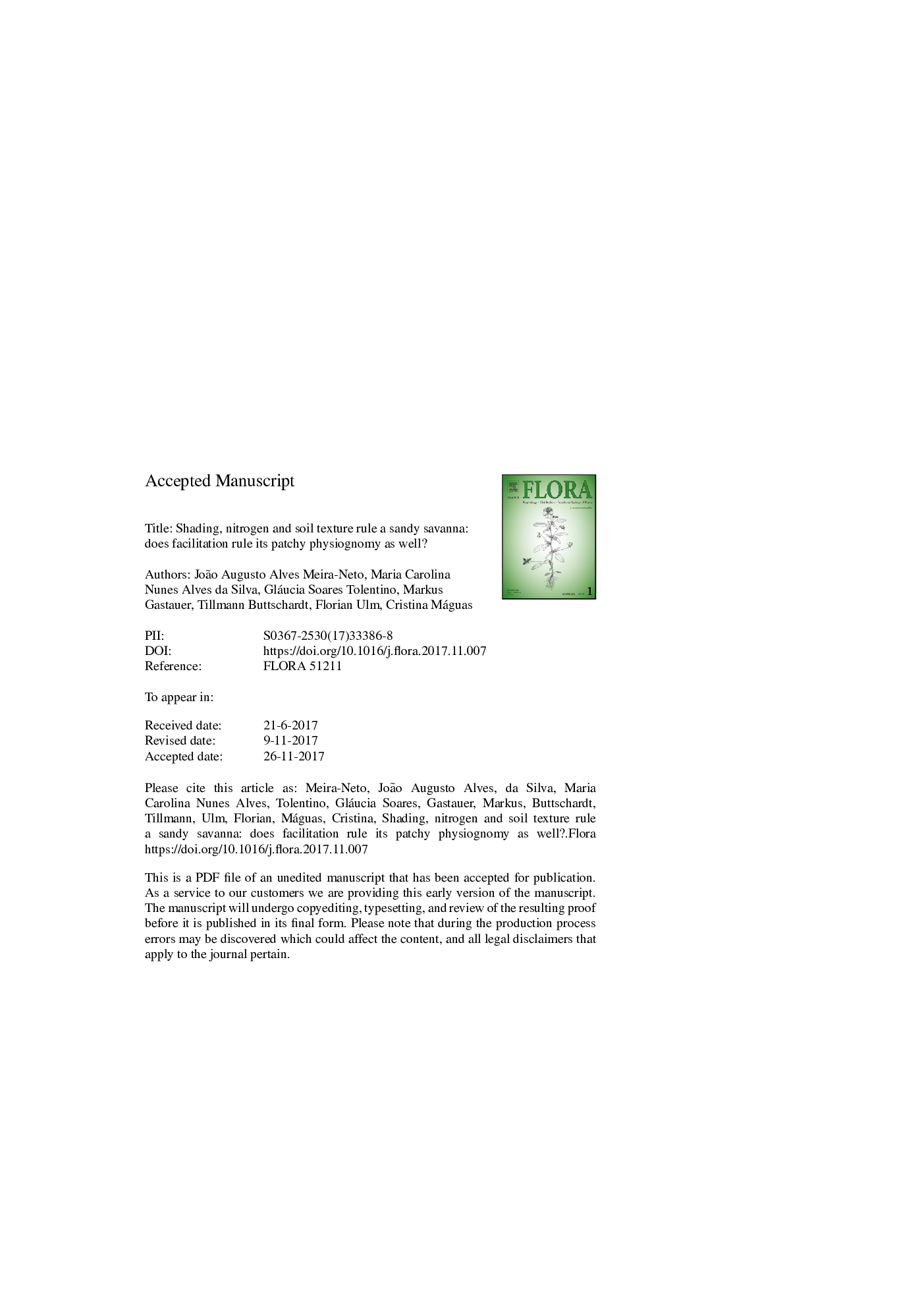| کد مقاله | کد نشریه | سال انتشار | مقاله انگلیسی | نسخه تمام متن |
|---|---|---|---|---|
| 8470200 | 1549921 | 2018 | 21 صفحه PDF | دانلود رایگان |
عنوان انگلیسی مقاله ISI
Shading, nitrogen and soil texture rule a sandy savanna: Does facilitation rule its patchy physiognomy as well?
ترجمه فارسی عنوان
سایه زنی، نیتروژن و بافت خاک، حاکمیت ماسایی شنی: آیا تسهیلات نیز این فیزیگونومی پراکنده را به چالش می کشد؟
دانلود مقاله + سفارش ترجمه
دانلود مقاله ISI انگلیسی
رایگان برای ایرانیان
کلمات کلیدی
موضوعات مرتبط
علوم زیستی و بیوفناوری
علوم کشاورزی و بیولوژیک
بوم شناسی، تکامل، رفتار و سامانه شناسی
چکیده انگلیسی
Oligotrophic sandy ecosystems have been the subject of investigations into understanding assembly rules because of their harsh conditions. Light, nitrogen availability and soil texture can cause constraints in oligotrophic sandy ecosystems, but can be attenuated by shading. This work aimed to answer the following questions. How do light (shading), soil texture and nitrogen interact in ruling an oligotrophic sandy savanna? Does the assemblage of patchy savanna differ from the assemblage of other physiognomies? If it differs, could the assemblage of patchy savanna be explained by plant-plant facilitation? Five circular plots (radius = 3 m) were established in each of five different physiognomies (25 plots in total): grassland, open savanna, patchy savanna, closed savanna and woodland. We identified and collected adult leaves of every individual plant inside the plots for measuring nitrogen (leaf nitrogen concentration, δ15N and C/N). We took hemispherical photos for quantification of light and collected compound soil samples for measuring soil nitrogen and soil texture. We performed generalized linear mixed models and richness estimates in order to test the influences of light (shading), nitrogen (leaf concentration, soil content, δ15N and leaf C/N) and soil properties on communities of a tropical sandy savanna. Light was not related to soil nitrogen, but was negatively related to leaf nitrogen concentration, to clay and to coarse sand, and positively related to fine sand. Leaf nitrogen concentration was negatively related to C/N and to δ15N. Compared to grassland and open savanna, patchy savanna, closed savanna and woodland were significantly richer in species and had higher leaf nitrogen concentration, higher leaf δ15N and lower leaf C/N. Patchy savanna was more shaded and had more species than expected, according to the relationship of light and species richness with fine sand. Compared to other physiognomies, the distinctive assemblage of patchy savanna suggests plant-plant facilitation as an assembly rule.
ناشر
Database: Elsevier - ScienceDirect (ساینس دایرکت)
Journal: Flora - Volume 239, February 2018, Pages 45-51
Journal: Flora - Volume 239, February 2018, Pages 45-51
نویسندگان
João Augusto Alves Meira-Neto, Maria Carolina Nunes Alves da Silva, Gláucia Soares Tolentino, Markus Gastauer, Tillmann Buttschardt, Florian Ulm, Cristina Máguas,
